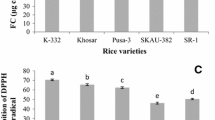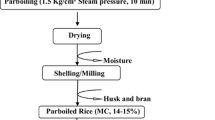Abstract
The present study is an investigation, into one of the varieties of paddy (Jyothi) its fortification with sodium iron EDTA salt, its physical properties, cooking characteristics, color, texture and characterization studies. Fortification was done at two concentrations 1.88 g/kg (T1 corresponding Iron content 0.25 g/Kg) and 3.39 g/kg (T2 corresponding Iron content 0.45 g/Kg). It was found that the iron content increased 2.5 folds after fortification, as compared to control sample. The results revealed that, there was significant difference between the physical properties of rice in the control, fortified brown and milled rice. The cooking parameters for control and fortified brown rice viz. cooking time, volume expansion water uptake were quite close to the control sample. The cooking time for fortified rice was 1–2 min high as compared to control, other parameters remained same. In case of milled rice, the cooking time and volume expansion for control milled rice and fortified was almost same; however the water uptake was higher for fortified milled rice as compared to control milled rice. The texture of fortified brown rice was hard as compared to fortified milled rice, although the taste was found satisfactory. The colour was significantly different in brown and milled rice. X-ray diffraction results revealed the polycrystalline nature of the fortified sample, was somewhat less crystalline as compared to control sample.


Similar content being viewed by others
References
Acquaviva R, Russo A, Galvano F, Galvano G, Barcellona ML, Li Volti G (2003) Cyanidin and cyanidin3-O-b-glucoside as DNA cleavage protectors and antioxidants. Cell Biol Toxicol 19(4):243–252
AOAC Official Methods of Analysis of AOAC (2000) International (17th ed) gaitherburg. AOAC International Inc., USA
Bhattacharya KR, Subba Rao PV (1966) Effect of processing conditions on quality of parboiled rice. J Agric Food Chem 14:476–479
Bhattacharya KR, Sowbhagya CM, Indudhara Swamy YM (1972) Some physical properties of paddy and rice and their interrelations. J Sci Food Agric 23(2):171–186
Chakrabarthy TK, Dwarakanath KR, Bhat BP (1972) Studies on physico-chemical properties of some varieties of rice. J Food Sci Technol 9:140–143
Chaudhary RC, Tran DV (2001) Specialty rices of the world a prologue. In: Chaudhary RC, Tran DV (eds) Specialty rices of the world: breeding, production, and marketing. Oxford & IBH Publishing Co, Pvt. Ltd., pp. 3–14
Cook JD, Reusser ME (1983) Iron fortification: an update. Am J Clin Nutr 38:648–659
Davidsson L, Kastenmayer P, Hurrell RF (1994) Sodium iron EDTA as a food fortificant: the effect on the absorption and retention of zinc and calcium in women. Am J Clin Nutr 60:231–217
Deepa G, Shanavas S, Singh V, Akhilender Naidu K (2012) Thermal and cooking properties of Indian medicinal rice Njavara in aqueous and milk media. Oryza 48(2):160–170
Guha M, Ali SK (1998) Parboiling of brown rice: effect of variety and parboiling conditions. J. Food Sci Technol 35(6):504–508
Halick JV, Kelly VJ (1956) Gelatinization and pasting characteristics of rice variety. Cereal Chem 36:91–98
Hogan JT (1963) Rice research at southern laboratory. Rice J 66(7):38–41
Islam MR, Shimizu N, Kimura T (2004) Energy requirement in parboiled and its relationship to some important quality indicators. J Food Eng 63(4):433–439
Juliano BO (1985) Rice: chemistry and technology. American Association of Cereal Chemists, Minneapolis
Juliano BO, Bautista M, Lugay JC, Reyes AC (1964) Studies on the physicochemical properties of rice. J Agric Food Chem 12:131–138
Little RR, Dawson EH (1960) Parboiling of rice. Food Res 25:611–615
Martines TC, Romano EL, Renzi M, Layrisse M (1979) Fe (III)-EDTA complex as iron fortification. Further studies. Am J Clin Nutr 32:809–816
Mohsenin NN (1986) Physical properties of plant and animal materials: structure, physical characteristics, and mechanical properties, 2nd edn. Publisher Gordon and Breach, U.K, p. 891
Noda T, TakahataY SST, Morishita T, Ishiguro K, Yamakawa O (1988) Relationship between chain length distribution of amylopectin and gelatinization properties within the same botanical origin of sweet potato and buckwheat. Carbohydr Polym 37:153–158
Parnsakhorn S, Noomhorm A (2008) Changes in physicochemical properties of parboiled brown rice during heat treatment. Agric Eng Int 55:259–261
Pillaiyar P, Mohandas R (1981) Hardness and color in parboiled rice produced at low and high temperature. J Food Sci Technol 18:7–9
Priestley RJ (1976) Studies on parboiling rice part 2: quantitative study of the effects of steaming on various properties of parboiled rice. Food Chem 1:139–148
Sashikala IS, Singh V, Ali SZ (2005) Changes in physico-chemical properties of basmati paddy upon parboiling. Trends Carbohydr Chem 9:53–59
Singh J, Singh N (2001) Studies on the morphological, thermal and rheological properties of starch from some Indian potato cultivars. Food Chem 75:67–77
Singh N, Singh J, Kaur L, Sodhi NS, Gill BS (2003) Morphological, thermal and rheological properties of starches from different botanical sources. Food Chem 81:219–231
Singh N, Inouchi N, Nishinari K (2006a) Structure, thermal and viscoelastic characteristics of starches separated from normal, sugary and waxy maize. Food Hydrocoll 20:923–935
Singh N, Kaur L, Sadhu KS, Kaur J, Nishinari K (2006b) Relationships between physicochemical, morphological, thermal and rheological properties of rice starches. Food Hydrocoll 20:532–542
Singh N, Nakaura Y, Inouchi N, Nishinari K (2007) Fine structure, thermal viscoelastic properties of starches separated from indica rice cultivars. Starke 59:10–20
Swain JH, Newman SM, Hunt JR (2003) Bioavailability of elemental iron powders to rats is less than bakery grade ferrous sulphate and predicted by iron solubility and particle surface area. J Nutr 133:3546–3552
Thai CP, Huang L, Fukai S, Rerkasem B (2011) Iron fortification in parboiled rice-a rapid and effective tool for delivering iron nutrition to rice consumers. Food Nutr Sci 2:323–328
Tyagi AK, Khurana JP, Khurana P, Raghuvanshi S, Gaur A, Kapur V, Gupta V, Kumar D, Ravi V, Viji S, Khurana P, Sharma S (2004) Structural and functional analysis of rice genome. J Genet 83:79–99
Vandeputte GE, Delcour JA (2004) From sucrose to starch granule to starch physical behaviour: a focus on rice starch. Carbohydr Polym 58:245–266
Zobel HF (1988) Molecules to granules: a comprehensive starch review. Stach-Starke 40:44–50
Acknowledgments
The authors acknowledge with thanks the support and co-operation received from Director, CSIR- Central Food Technological Research Institute, Mysore, Karnataka.
Author information
Authors and Affiliations
Corresponding author
Ethics declarations
Conflict of interest
None.
Compliance with ethics requirements
This article does not contain any studies with human or animal subjects.
Electronic Supplementary Material
ESM 1
(DOCX 1206 kb)
Rights and permissions
About this article
Cite this article
Pandey, S., MR, A. & A, J. Changes in physical, cooking, textural properties and crystallinity upon iron fortification of red rice (Jyothi). J Food Sci Technol 53, 1014–1024 (2016). https://doi.org/10.1007/s13197-015-2130-7
Revised:
Accepted:
Published:
Issue Date:
DOI: https://doi.org/10.1007/s13197-015-2130-7




